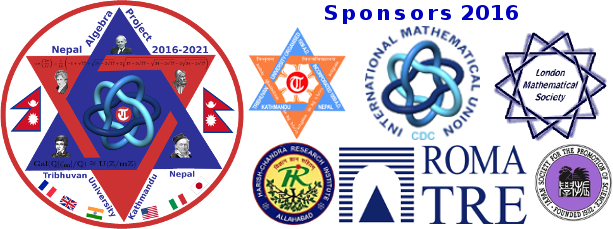Nepal Algebra Project (NAP) / नेपाल बीज-गणित परियोजना

COURSE YEAR 2016
Module - III : June 05, 2016 – June 17, 2016,
Nick Gill
Topics: The fundamental theorem of Galois theory (FTGT), Examples and applications of FTGT, Constructions with straight-edge and compass, The Galois group of a polynomial, Solvability of equations
(also download from here)
- We restated the Fundamental Theorem of Galois Theory. We also stated a version for field extensions that are not Galois (this is not in Milne).
- We discussed Example 3.21 of Milne, calculating the full lattice of intermediate fields in the extension $\mathbb{Q}[\zeta]/\mathbb{Q}$ where $\zeta$ is a primitive $7^{th}$ root of unity.
- Review of fundamental concepts from group theory, Notion of a "transitive permutation group", Statement of the Orbit-Stabilizer Theorem, which proof was left as an exercis
(also download from here)
- Review of fundamental concepts from group theory by discussing semi-direct products. We considered a range of examples (and a number of supplementary exercises were given during the lecture). We noted that one way to distinguish between $D_4$ and $Q_8$ is that the former is a semidirect product $C_4\rtimes C_2$, while the latter is not.
- We then applied our knowledge of semidirect products to a careful study of Example 3.22 of Milne: here we considered the field extension $E/\mathbb{Q}$ where $E$ is the splitting field of $X^5-2$. We followed Milne's treatment in calculating the Galois group $G$ of this extension, and considered how to describe this group accurately as a semidirect product. We also extended Milne's treatment by considering the subgroups of $G$ of order $2$ and $10$, and students were asked to calculate the fixed fields of (some of) these groups as a supplementary exercise.
(also download from here)
- We defined the Galois group of a polynomial, and discussed how we can use properties of permutation groups to calculate the Galois group of a polynomial.
- We revisited Examples $3.21$ and $3.22$ of Milne from this perspective. In particular we noted that in both cases the Galois group was a TRANSITIVE permutation group. We gave a proof of the implication $f$ irreducible $\Longrightarrow$ the Galois group of $f$ is transitive.
- We briefly discussed whether the converse might be true -- the exact statement will be given by Professor Waldschmidt.
- The final hour of the lecture was devoted to exercises.
(also download from here)
- Defined a constructible point using the definition given in Garling.
- We then formally defined a constructible number to be a number $c$ such that the point $(c,0)$ is constructible. (A formal definition is not given in Milne.)
- Writing $\mathcal{C}$ for the set of all constructible numbers, we proved that
- The set of all constructible points is $\mathcal{C}\times \mathcal{C}$;
- $\mathcal{C}$ is a field that contains $\mathbb{Q}$;
- Theorem 1.6 of Milne: a real number $z$ is constructible if and only if it is contained in a field of form $\mathbb{Q}[\sqrt{a_1}, \sqrt{a_2},\dots,$ $\sqrt{a_k}]$ where $a_i>0$ and $a_i \in \mathbb{Q}[\sqrt{a_1}, \sqrt{a_2},$ $\dots, \sqrt{a_i}]$
- if $z$ is construcible, then $z$ lies in an extension $E$ such that $|E:\mathbb{Q}|=2^k$. In particular $\mathcal{C}$ is contained in the set of all algebraic numbers but, on the other hand, $\sqrt[3]{2}$ is not constructible.
(also download from here)
- Formally defined an angle $\theta \in[0,2\pi)$ to be constructible if the point $Q=(x,y)$ is constructible and the angle $P_1P_0Q=\theta$. (This definition is not given in Milne; recall that $P_0=(0,0)$ and $P_1=(1,0)$.)
- We observed that $\pi/2$ and $\pi/3$ are both constructible and that, since we can bisect angles, we can construct many angles.
- Used the triple angle formula for $\cos$ to show that $\pi/9$ is not constructible.
- Formally defined a regular $n$-gon to be constructible if the angle $2\pi/n$ is constructible. (This definition is not given in Milne.)
- We constructed an equilateral triangle, and a square and, again because of angle bisection, showed that we can construct many $n$-gons.
- We proved that if $p$ is a prime, and a $p$-gon is constructible, then $p$ is a Fermat prime.
- We briefly discussed why the regular $5$-gon and $17$-gon are constructible, and then spent time discussing last week's exercises.
(also download from here)
- We calculated the Galois group of $X^6+1$ over $\mathbb{Q}$, as this was requested by students.
- We partially proved that if a number $z\in\mathbb{R}$ lies in a GALOIS extension of $\mathbb{Q}$ of degree a power of $2$, then $z$ is constructible. (The remainder of the proof is included as one of the exercises in the second homework.)
- We proved that if $p$ is a Fermat prime, then the regular $p$-gon is constructible.
- The rest of the lecture was devoted to discussing the second homework exercises.
Homeworks:
problem set 1,
problem set 2
Solutions:
problem set 1
Model question for exam:
download here